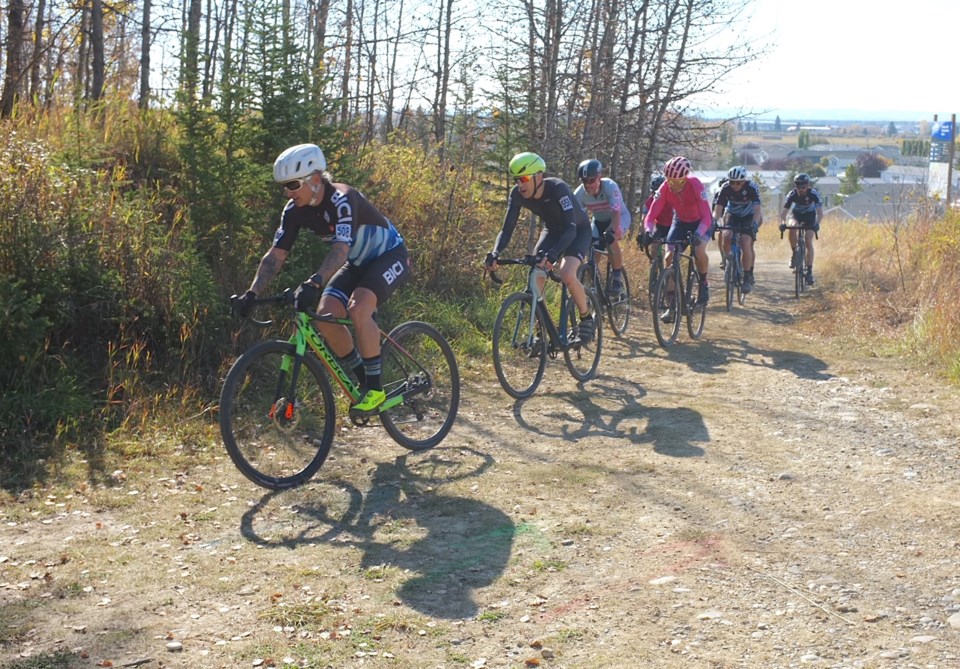SUNDRE — Both novice and experienced cyclocross racers recently put their abilities to the test at Snake Hill during the second edition of Snakes and Ladders Cyclocross.
“It’s a unique course,” said race organizer Felix Lee, who lives in Olds. “It’s probably the hilliest course in the province.”
Lee, who is also a member of the Central Alberta Bicycle Club as well as the Sundre Bike n’ Ski Club, said during an interview on Oct. 13 that Snake Hill is essentially ideal for mountain biking but rather challenging for cyclocross.
“As far as cyclocross goes, we’re really pushing the limits on what’s allowable. It’s a very different kind of course layout than we typically see in Alberta,” he said.
The races’ outcomes – there were four men’s, two women’s, as well as a youth category – revealed that difference, he said.
“The results show that the people who are typically at the top of cyclocross racing were not the winners there,” he said. “It shook up the leaderboard quite a bit for the open women and the open men. It makes the racing a little bit more interesting because we’re not seeing the same people on the podium every single time.”
Additionally, Snake Hill provides an all-weather venue in which events can proceed regardless of rain or snow, he said.
“That’s really helpful, especially this time of year,” he said.
While it’s been a mild season so far, he added that had this fall’s weather been wet as is not historically uncommon, courses in Calgary and Edmonton would not allow races to go ahead.
“So, it’s nice to have that security knowing that no matter the weather, we can race there,” he said about Snake Hill.
About 70 people – including some locals but mostly visitors from out of town – participated in the Saturday, Oct. 8 race that was put on by the Central Alberta Bicycle Club in partnership with the Sundre Bike n’ Ski Club. In the days leading up to the event, Lee had previously said about 45 had registered in advance.
“It’s a little lower than I was expecting,” he said. “But everyone this year has been experiencing lower-than-usual turnout to races I’ve been to.”
Regardless, Lee expressed no regrets and said hosting the event is good for the clubs involved.
Local races such as Snakes and Ladders offer racers a chance to build up their rankings for a shot at provincials, which are coming up at the end of October in Calgary, he said, adding there were also a number of prizes donated by sponsors.
Asked to elaborate on the difference between mountain biking and cyclocross, Lee said the latter is far more limited when it comes to what kinds of bikes racers can use.
“The equipment in cyclocross is quite a bit more restrictive than mountain biking, so there’s a lot of rules,” he said. “It really does put everyone on a more equal footing with the restrictions on the bicycle.”
In a nutshell, cyclocross racers all ride bikes with similar, nearly-identical specifications; fancy features like suspension not included.
“I enjoy it more because it’s more of a rider’s skill and fitness coming into play than equipment is as opposed to mountain biking because the equipment across the riders is pretty much the same,” he said.
The most expensive mountain bikes made for racing can hit a price tag upward of $10,000, he said.
“The price difference in the cyclocross bikes is much smaller because there’s less room for innovation compared to mountain bikes,” he said.
Cyclocross racing is also different from mountain biking events in that contenders compete against the clock as opposed to completing a set distance.
“Mountain biking is a fixed distance, but cyclocross is a fixed time,” he said.
Snake Hill will remain in the repertoire of courses to continue hosting annual races like cyclocross, he said.
“It’s a tough one; there’s a few people who won’t go to it because of how hard it is,” he said about Snakes and Ladders. “But it’s one that I intend to keep putting it on.”



